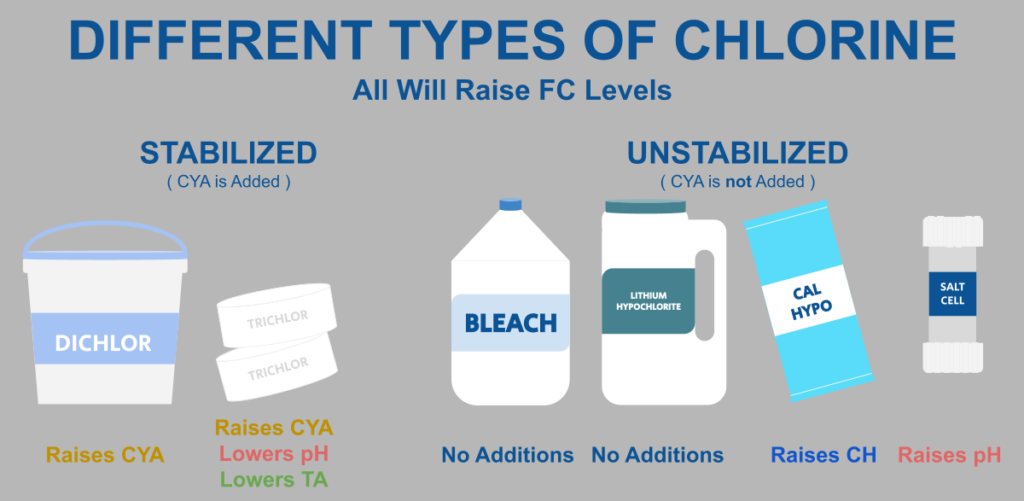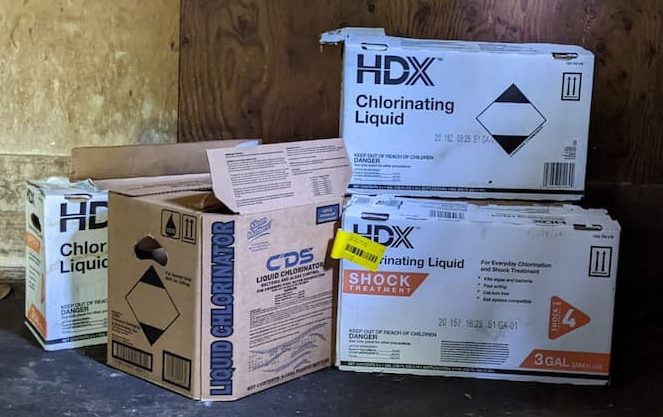Chlorine is the most popular sanitizer for pools due to its widespread use, lower price, and availability.
There are four different types of chlorine to use: sodium hypochlorite (bleach), calcium hypochlorite, trichlor, and dichlor.
Not only does it target and kill microorganisms in pool water, but it also carries an extra function as an oxidizer that burns up organic contaminants introduced into the water by nature (leaves, pollen, dirt) or swimmers (lotion, body oils, sweat).
Quite simply, pool chlorine acts as a fixer and as a preventer.
The Difference Between Stabilized and Unstabilized Chlorine
Chlorine falls into two categories, in the most basic sense: stabilized and unstabilized.
Stabilized Chlorine
Stabilized chlorine contains cyanuric acid (CYA). Since CYA does not break down in sunlight, the chlorine will last longer in the pool, allowing you to add it less frequently.
Keep in mind that too much CYA in the water can inhibit chlorine’s ability to sanitize, so make sure your CYA levels are not too high before using stabilized chlorine.
Unstabilized Chlorine
Unstabilized chlorine has no stabilizer added, so CYA needs to be added separately. Otherwise, UV rays will break down unstabilized chlorine faster, forcing you to use more chlorine.
This further highlights the importance of having balanced water and enough stabilizers like CYA to control chlorine use.
READ MORE: The relationship between Free Chlorine (FC) and Cyanuric Acid (CYA)
The Different Types of Chlorine and Their Attributes
As mentioned above, there are four different types of chlorine that you can use to sanitize your swimming pool:
There is one additional chlorine form for pool owners with a saltwater pool. These pools transform salt into chlorine granules using a saltwater chlorine generator (SWG).

Listed below are the various forms of chlorine along with best practices for each.
Sodium Hypochlorite (Liquid Chlorine or Bleach)
Pros
Cons
Liquid chlorine is an unstabilized form of sanitation. Most know it simply as household bleach, but you want to avoid bleach products with scents, fabric enhancers, or other additives. Liquid chlorine can be found at most big box and home improvement stores and is a great way to sanitize your water.
It is typically the least expensive, but since it is unstabilized, it will burn off quicker, meaning more needs to be added frequently. However, since it doesn’t add any other chemicals to the pool it is the most recommended form for daily use.

How to Add Liquid Chlorine to Pool
Slowly pour the amount you need in the deep end close to a return jet. Dumping a full gallon shouldn’t take less than a minute.
Calcium Hypochlorite
Pros
Cons
Commonly referred to as cal-hypo, this is another unstabilized sanitizer that comes in powder form. You’ll be able to find cal-hypo in pool stores as well as some home improvement retailers. Some pool stores will sell cal-hypo as “shock”.
While cal-hypo will not add CYA to the water, it will raise calcium hardness (CH) over time. Too much CH can introduce scaling and cause the water to become cloudy. It is important to ensure CH levels are within range when using cal-hypo.
How to Add Calcium Hypochlorite to Pool
There are two general ways to add cal-hypo. The first way would be to broadcast the amount needed in the deep end. Most granules will dissolve before hitting the bottom of the pool. Use your pool brush to disperse the rest that lands at the bottom.
The other and more effective way would be to pre-dissolve the cal-hypo in a bucket of pool water, mixing it with a stick to ensure all granules are dissolved before dumping it into the water.
Trichlor
Pros
Cons
Trichlor is a stabilized sanitizer commonly referred to as tabs or pucks. When pool owners use floating devices, they use trichlor tabs.
Trichlor is the slowest form of chlorine to dissolve and gets dissipated over a longer period of time, making it less of a hassle when it comes to overall sanitation.
However, since it is stabilized, it will increase CYA over time. Additionally, trichlor will lower pH and total alkalinity (TA) since it contains acid.
How to Add Trichlor to Pool
Trichlor can be added through a pool floater.
Dichlor
Pros
Cons
The other stabilized sanitizer, dichlor, mostly comes in powder form but can also be found as tablets. Because it dissolves quickly, pool stores generally sell this as “shock.”
How to Add Dichlor to Pool
Dichlor in powder form can be pre-dissolved in a bucket of water before adding to the pool. If it is in a tab form, use your pool floater.
Salt Water Chlorine Generator (SWG)
Pros
Cons
Utilizing an SWG is another way to chlorinate your pool. It essentially converts salt in the pool to chlorine, making the sanitation process fairly easy.
However, you must purchase a fairly expensive saltwater generator to add to your plumbing equipment. Some may consider that too much and prefer to chlorinate in other ways.
How to Add Salt to Pool
Salt can be added by broadcasting it in the deep end. Any granules that reach the bottom can be brushed until fully dissolved.
What Chemical Levels Are Affected By Chlorine?
Since chlorine is the cornerstone of cleanliness, it naturally affects pool chemistry.
Whether using test strips or a liquid test kit to check water levels, chlorine has some affecting relationship with:
- Free Chlorine (FC): The overall level of sanitation in the water that kills all the germs, algae, and other contaminants that may be living.
- Combined Chlorine (CC): The reaction of free chlorine binding with organic contaminants and ammonia in the water during sanitation. Also known as chloramines.
- CYA: As mentioned previously, CYA is a chlorine stabilizer that protects it from UV rays, making it last longer in the water.
Chlorine Demand and Chlorine Lock
Naturally, algae and other organic materials consume the chlorine added to the pool. This consumption is known as chlorine demand, defined as the “amount of chlorine that will react with contaminants before any chlorine is left unreacted.” The more crap in the water, the more chlorine is needed.
There are some misconceptions about chlorine not working, no matter how much is put in the pool. This is commonly called chlorine lock; your chlorine levels will not increase even when more has been added. By and large, chlorine lock isn’t a real thing.
However, when CYA levels are too high, the amount of chlorine added might not be enough. So it isn’t “locked”; there isn’t enough chlorine in your pool.
Bottom Line
While other sanitizers can be used, chlorine is the easiest and most affordable choice. Just remember, any sanitizer is only as effective as your water testing!
